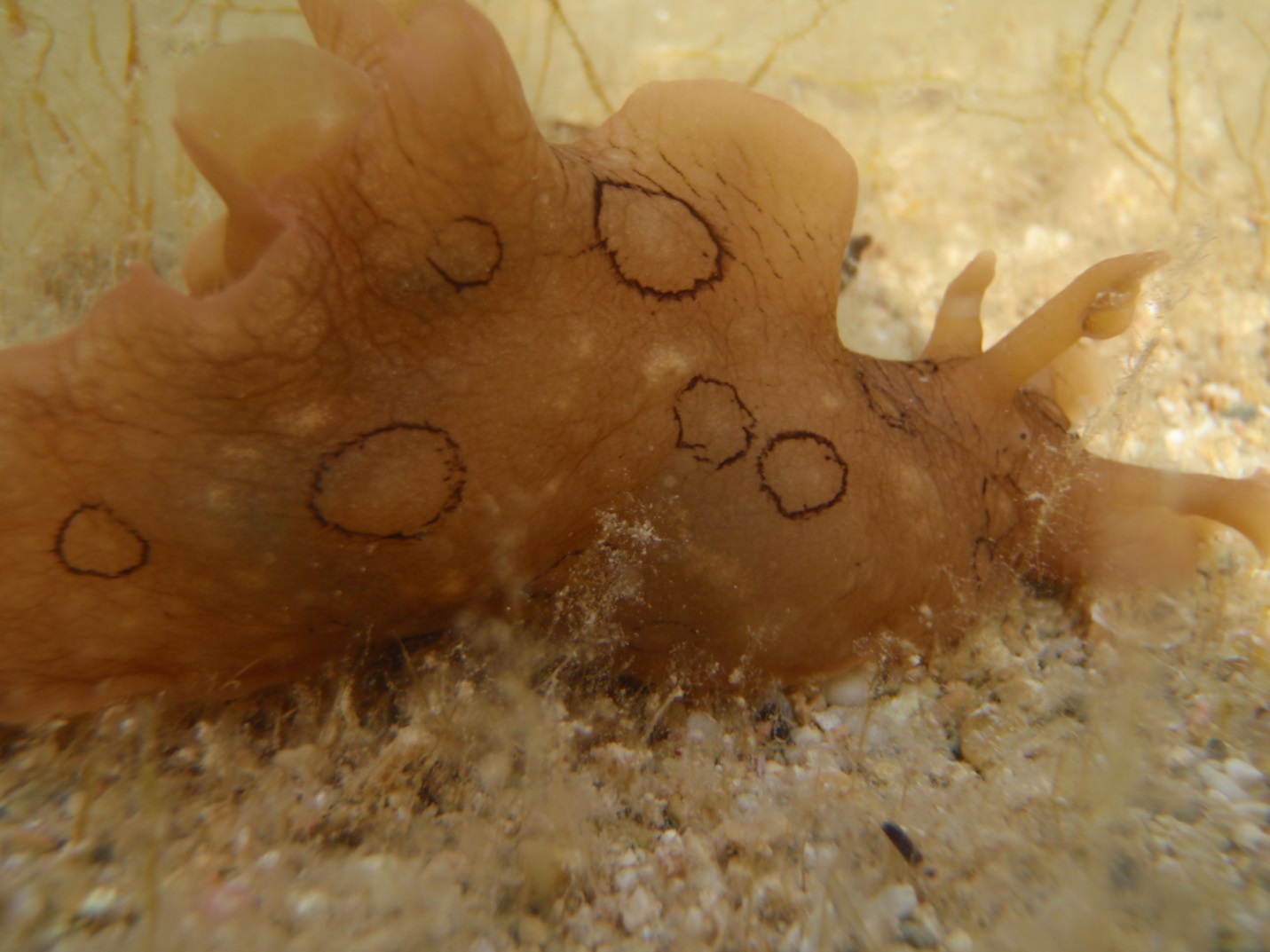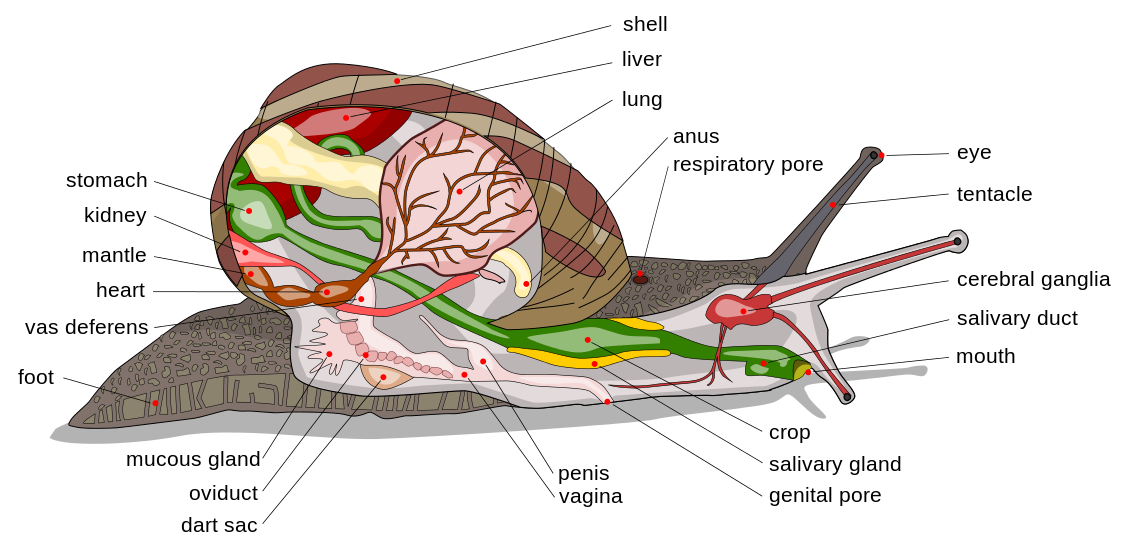Form and Function
Navigation Back to Classification - Home - Continue to Life Cycle / Reproduction
Jump to Section
Overview
-
Shell -
Foot
-
Parapodia
-
Movement +
Function
Inking
-
Behavior -
Conclusion
Overview
Aplysia dactylomela is a large, slug-like animal with a fleshy appearance quite similar to a Jellyfish, or the Portuguese Man of Water. It averages in length from 15-16 cm as an adult, but can grow as large as 40 cm long, and weight in at over 5 kg (EOL n.d.(b), Overly n.d., University of Miami 2009) . A Sea Hare, this organism’s rhinophores resemble the ears of a rabbit, hence the name 'Sea Hare' (Overly n.d.). It has a very subtle color theme, ranging from pale yellow to light brown, with many shades of olive green and cream. The shade and color varies with the food it eats. Red Algae, A. dactylomela’s preferred food, results in a rather orange color tone. In general, however, it is a beautifully patterned, soft-bodied animal. (Overly n.d., Emore 2002, EOL n.d.(b))

Image courtesy Scott A-P Muzlie, Wikipedia
An apomorphy that separates this taxon from its sisters is the presence of irregular black rings both on the inside and outside of the parapodia. On the dorsal surface of the mantle and parapodia, these black rings appear merely as irregular blotches (Emore 2002). However, the rest of the body of the organism is covered in more complete circles, which are connected together in an intricate pattern of black lines, accentuated every now and then with cream spots. (Emore 2002, EOL n.d.(b)).
Shell
Aplysia dactylomela’s internal shell, enclosed in the mantle, is highly reduced, flat, and fragile (Emore 2002, Bolland 2001). The consistency of cardboard, it is not sturdy enough to provide support for the animal itself (Overly n.d., University of Miami 2009). Thus, A. dactylomela is quite slug-like in appearance (University of Miami 2009). The shell is hypothesized to be the vestigial remnant of a shelled gastropod ancestor (Overly n.d., Bolland 2001). It does, however, function to cover the visceral mass, and mainly the heart and other essential organs located there (University of Miami 2009).

Image courtesy ArnoldReinhold, Wikipedia
Back to Top
Foot
The foot is broad and well-developed, covering nearly the entire underside of the animal (Emore 2002, University of Miami 2009). Near the anterior end of the organism, the foot is rounded, while at the posterior end it comes down to a blunt point (Emore 2002). In contrast to the smooth texture of the rest of the body, it is quite rough (Emore 2002).
Parapodia
Next are the parapodia. An important distinguishing characteristic of A. dactylomela, these two large dorsal, wing-like extensions of A. dactylomela’s foot are part of the mantle, resembling long ears, such as those of a rabbit (Overly n.d.). Possibly more importantly, they have black markings on both the inside and outside, contrary to other species in the genus Aplysia (Rudman 1999). They are tough and leathery (Rudman 1999). Their location high on the animal and their thin thickness actually allows this animal to swim in the water column (Emore 2002).

Typical anatomy of a common land snail
Movement + Function
Normally as an adult, this organism is nocturnal, and only goes through its slow movements after dark has set in. A controvertial topic to discuss about the sea hares is swimming. Although it is quite easy to mistake a sea hare that is simply floating down the water column after being released into the water, flapping its parapodia, for swimming, the organism is not. Whether or not this organism swims or cannot swim (the literature is unclear as to which is correct), A. dactylomela can look like it's swimming by first folding the parapodia forward and down, which creates a funnel that pulls in water. Then, by pressing the anterior parts of its parapodia together and forcing out the water behind itself, Aplysia dactylomela is propelled forward (Emore 2002).
Much more common than this swimming motion, however, is merely crawling along on the substrate at the bottom of the water. Also known as contractive wave motion, crawling is done by simply raising the leading edge of the foot and stretching it forward in a long, slow arching pattern. Much like an inchworm, the rest of the body follows until the tail of the organism is at last caught up to the rest of the body. Then, the process is repeated over again (Emore 2002).
Opisthobranchia literally means ‘Gills behind,’ referring to their place behind the heart of the organism. Located on the right side of the mantle right between the shell and the right parapodia, the gills are covered by the parapodia themselves. Through the use of a siphon (tube) modified from the mantle, water is channeled through the parapodia flaps and thus through the gills, allowing the animal to breathe (University of Miami 2009).
Back to Top
Inking
Another characteristic of the Opisthobranchia is their ability to ink. Believed to be a defense mechanism against predators, a purple dye is released when the Aplysia dactylomela is disturbed (Overly n.d., Tobach et al. 1989). This dye is an irritant to both invertebrates and fish (Nusnbaum 2010). From its preferred red algal food, pigments are extracted that both create the purple dye and make the organism’s flesh quite distasteful to predators (University of Miami 2009). The purple color of the ink is caused by the chemical aplysioviolin, a deterrant against predatory crabs, which does not function as an aposematic signal (Nusnbaum 2010).

Image of Aplysia dactylomela releasing purple dye
Photo taken by Alison Copeland, Department of Conservation
Services, Bermuda
Used with permission
Common among the Sea Hares are their rhinophores. These two antenna-like structures are located at the top of A. dactylomela’s head, and make the gastropod appear much like a rabbit with its long ears. These rhinophores, along with a pair of large anterior tentacles, which meet at the mouth, located on the underside of the head, are utilized as sense organs, having purposes such as locating food, other Aplysia, and even sensing danger. Directly in front of these rhinophores are A. dactylomela’s small, pinpoint black eyes. They aren’t very powerful, and don’t help the organism very much. Moreover, it relies heavily on its rhinophores and anterior tentacles to detect objects and conditions in its surrounding environment (University of Miami 2009).
Behavior
Aplysia dactylomela can respond to its environment, and can be conditioned to respond to a stimulus in a certain way. A great example is its siphon withdrawal. When disturbed, A. dactylomela will pull its siphon back into its mantle cavity to keep it safe. This reaction can be induced through experience (touching the siphon), or through electrical shock (University of Miami 2009).
The Spotted Sea Hare exhibits three learning levels. The first is habituation. This is occurs when the organism’s responses decrease as a stimulus is repeatedly introduced to it. Second is sensitization. Nearly the opposite of habituation, the response of the organism is actually enhanced (grows stronger) as a harmful stimulus is repeatedly presented to the organism. Thirdly, this organism exhibits classical conditioning. At first, the Sea Hare is stimulated by both a siphon touch and a tail shock. Eventually, the tail shock is removed and the only stimulus the organism receives is a siphon touch, yet the same reaction still results (University of Miami 2009).
In addition, Aplysia dactylomela form into aggregations through a complex pattern. For one, they move toward a source of conspecific stimulation, and food and current stimulations also have an effect on the approach of the organism (Lederhendler 1977). One the other hand, however, no substance is released during copulation that would either attract or repel another sea hare (Lederhendler 1977).
Another interesting behavior is Aplysia dactylomela's preference of red algal food. Although it has been suggested that A. dactylomela ingests red algal food to extract molecules that aid in preventing predation of itself (Tobach et al. 1989), another interesting point is that mycosporine-like amino acids (MAA's), found in red algae, helps to protect A. dactylomela and its eggs from UV radiation, thus acting as a sort of sunscreen (Carefoot et al. 2000).
Conclusion
Thus, Aplysia dactylomela is a fairly large, soft-bodied, slug-like creature beautifully patterned with many pleasant green and brown color shades. Covered in irregular black rings, this organism can swim in the water column and crawl on the substrate, as well as respond to stimuli and defend itself against predators through its purple dye. It is through its rhinophores, which present the animal as having ears, that Aplysia dactylomela receives its nick-name, the Spotted Sea Hare.
Back to Habitat / Geography - Home - Top of Page - Continue to Life Cycle / Reproduction
